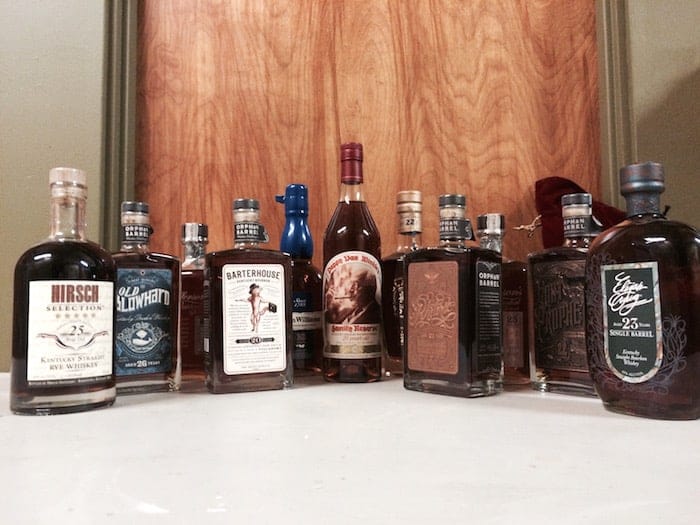Editor’s Note: This article on whiskey age is a repost from the Journeyman Distillery blog and is reprinted with their permission. Author credit goes to distiller Nick Yoder. Want to contribute your own voice to a guest post? Drop us a line with your pitch.
15. 20. 23. Those aren’t the winning numbers from last night’s lottery. Those are the ages of a rather popular bourbon that is harder to find than Waldo at a candy cane convention. You probably know which one I’m talking about. Hint: It rhymes with “happy”, which is exactly the opposite of what you’ll be if you try to hunt a bottle down at a reasonable price.
Those ages are meant to imply that the whiskey in the bottle is better because it has spent over a decade or two in a barrel. Whiskey that’s been in the barrel for 15 years obviously has to be better than something that’s been in the barrel for 14 years, right? And something that’s only been in for 5 years or, say, 6 months, couldn’t even hold a candle to it, right? Here’s a dirty little secret the big guys won’t tell you. Age is hardly more than a number and has much less effect on the taste of the product than most would lead you to believe. In fact it’s entirely possible for a whiskey to spend too much time in the barrel. Age statements on whiskey are pure marketing at its best (and worst).

When new make whiskey enters the barrel, it settles in for a time to pick up both flavor and color from the barrel. The barrels are charred on the inside, which serves two purposes. The charring caramelizes the sugars in the wood, allowing it to impart those familiar caramel, toffee and vanilla notes in the whiskey. It also opens up pathways that make it easier for the liquid to move in and out of the wood. It’s the heating and cooling of the whiskey as the temperature outside the barrel fluctuates that expands and contracts it in and out of the wood, picking up tannins, flavor and color each time.
So many other factors are at play in the aging of the spirit that the duration it has been in the barrel has little bearing on what it actually tastes like. Ever noticed that Scotch tends to be aged longer than other whiskeys? That has everything to do with how Scotland’s climate differs from the United States. The temperature is much cooler on average and doesn’t fluctuate as much. Thus the whiskey does not contract and expand in the barrel as rapidly, which means it takes longer to pick up the flavor from the wood. Compare that to the hot summers and cold winters here in Michigan, where the drastic temperature differences moves the whiskey in and out quickly and quickens the acquisition of flavor.
Barrel size also has an influence on how quickly a spirit ages. The smaller the barrel, the greater the percentage of spirit in relation to the surface area. This greater percentage of spirit in contact with the wood helps speed up the aging process. That’s why we predominantly use 15 gallon barrels (and 5 gallon barrels for Silver Cross). As a young distillery without years and years of whiskey in storage, we have to find ways age our whiskeys to the right flavor profile quickly. The big distilleries use 53 gallon barrels, which age the whiskey more slowly.
Those aren’t the only factors at work but I’ll spare you even more whiskey geek talk. What does this all mean? The same whiskey is going to age much more slowly in a 53 gallon barrel in a climate that doesn’t see much temperature fluctuation than it would in a 15 gallon barrel in a climate with wild temperature swings. There’s no simple, easy way to translate all these factors into a simple number that means the same thing across the board.
And have you ever heard of the law of diminishing returns? It’s an economics term that explains the decrease in the marginal output of a process as a single factor is incrementally increased. Applied to whiskey it means that each year in the barrel produces smaller and smaller flavor changes. Let’s pretend there’s a Whiskey Flavor Unit (WFU). In year one, the whiskey may acquire 10 WFU’s from the barrel. In year two it might only get 6 WFU’s. By year three it’s down to 4 and year four it only picks up 2. Thus a whiskey aged 15 years does not have 15 times more mythical WFUs than one aged 1 year.
Not to mention that it is entirely possible for a whiskey to age for too long in the wood. There’s a point where the charred wood overpowers everything else and it starts tasting like sawdust water. You could save a lot of money just drinking sawdust water instead.
I’ll go into further detail about how age statements became a driving factor in the perception of quality another time. For now, grab yourself a bottle of Silver Cross (aged on average six months in 5 gallon barrels) and pour yourself a couple fingers of the spirit Distiller rated two points higher than Pappy 15 and 23.








